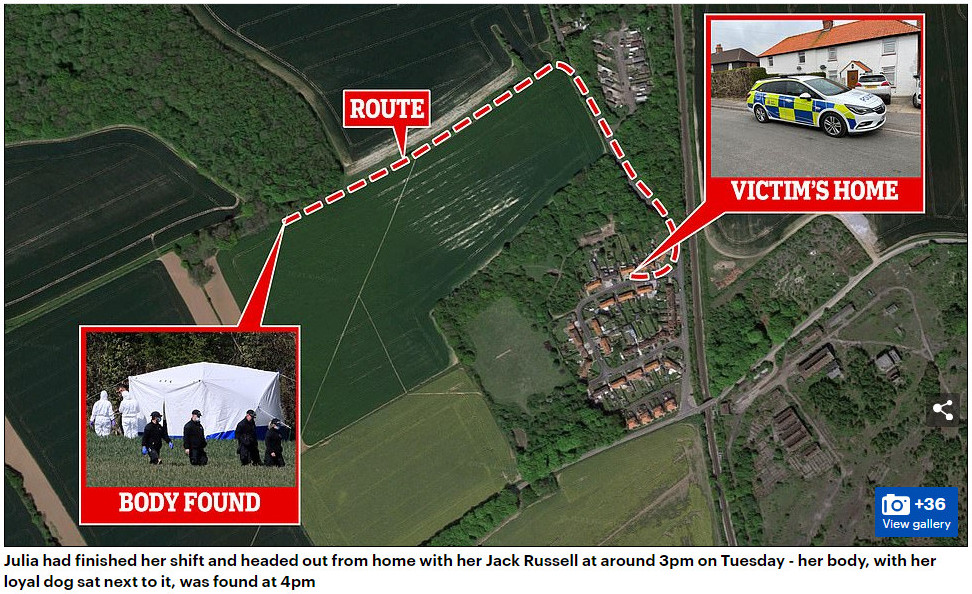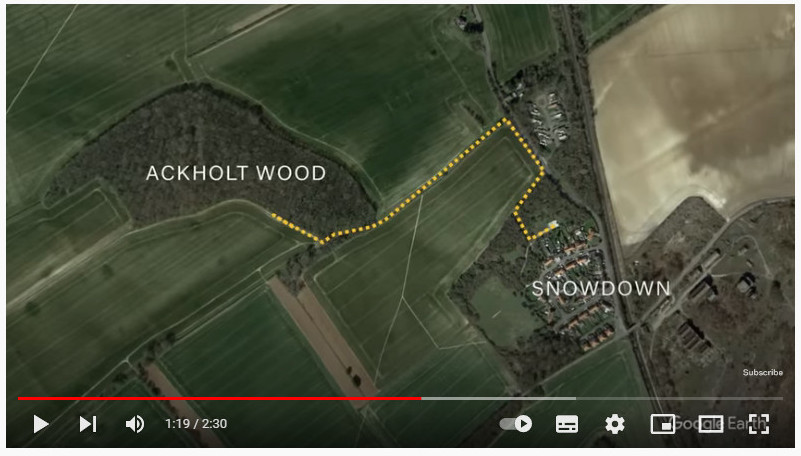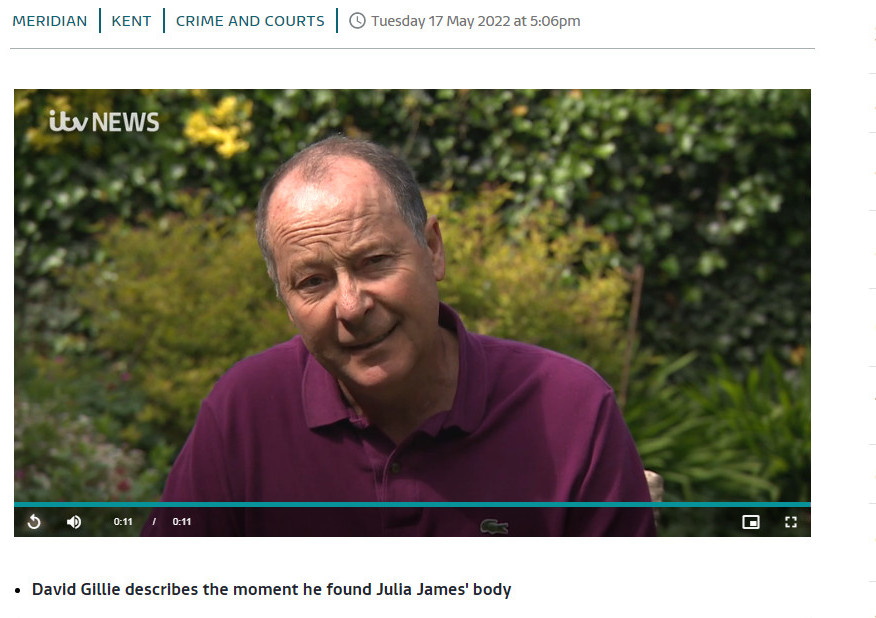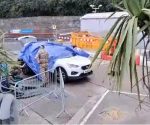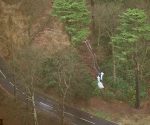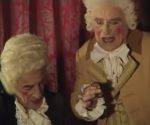Julia Ghost: the perennial disposable first script, and other plot holes regarding her movements and discovery of the body
In April 2021, Sean Simmonds lived on the same street as did Julia James. On the day she was murdered, the 27th, he had seen her at the start of a walk with her dog on the other side of the road from where he was positioned in his front yard. This was about 3pm. As her body was discovered just around an hour later, he perhaps naturally felt that he would have been the last person to see her alive. At least, this is what was reported copiously and variously in corporate-media in the days immediately after the death. Indeed, his being quoted over again in MailOnline and The Sun rehashes of their own articles (as they are wont to do) somewhat anchored the narrative on the occasion of it being born, because it verified Julia James as a real person living in the hamlet of Snowdown, the general scene of the crime, and it verified Julia James had natural cause to be visiting nearby Ackholt Wood, the specific scene of the crime. Indeed, Simmonds was able to give the impression of James as a well rounded character: she told him she was a PCSO who worked with victims of domestic violence; she was always in a good mood; he often bumped into her in the fields as he also walked his dogs; she’d never told him that she’d ever had enemies through her work; etc.
Later on, of course, Sean Simmonds’ story about spotting Julia James was cut hopelessly adrift from the truth when it emerged that James had left her house much closer to 2pm, and had gone by a way that went directly into the fields via the rear of her property so that she would not have been seen as her neighbour had claimed (“Jurors were shown a map, which shows the route Julia took through her back garden, around a field and to the ‘butterfly place’ in Ackholt Wood, before turning back on herself” [source]). The images below illustrate the point, as do quotes from Simmonds to be presented shortly. As far as the two graphics go, the first is from the MailOnline, produced as early as April 30th (2021), and the second is a still from a Channel 5 programme (via YouTube) from the same time as Callum Wheeler, the man accused of the crime, was found guilty on 16th May of this year.
People who want to rationalise this will say that Sean Simmonds was merely mixed up on his days, saw James at another time, but was mistaken in reckoning that it had been on the fateful day. It’s not good enough, however. The information that undermines Simmonds suggests Julia James potentially never took a route whereby she could seen by Simmonds.
Such is the lack of wiggle room for apologists, the question to ask at this juncture is not why Sean Simmonds could have been so terribly wrong, and yet be so widely disseminated by a corporate-media that failed to do the most basic of fact checking, but instead why is it that there can be a situation whereby an intelligence operative can write an extensive script for a part to be played by a supposed local resident, all in order to seed a narrative – which is the explanation that best fits this “disposable or dispensable first script” phenomenon that we see over again in such circumstances – and then have it presented by diverse and obliging outlets of corporate-media? Well, the author calls it Mi7 being alive and well but undisclosed and unexposed, and it’s an incredible situation to have when the alternative media has never been more profuse. However, the bigger shame is how there is no evident power of discernment in the consumer of alternative media (not one jot of which would see the liberation of its audience from ignorance as a benefit), when Mi7 is so very obvious and yet so fearless in its working with impunity to form false first-instance perception as part and parcel of a recognisable state crime along with its police cover up.
There was a clue about Sean Simmonds’ when, at the same time (in the very same article) as the Daily Mail was publishing his claim of seeing Julia James embarking on her walk, it was publishing something else that suggested that he hadn’t seen such a thing after all. The script, then, had two versions, with the one to be used, the author would suggest, depending on a decision to be made on how to use Simmonds. As it turned out, a mistake was evidently made, and the stenographer (“journalist”) who constructed the particular Daily Mail piece from memos included text for the option that wasn’t taken. Firstly, there was this:
Sean Simmonds, who lives opposite the semi-detached, three-bedroom home Mrs James shares with her husband Paul, said he saw her leave the house to walk her dog at 3pm yesterday but did not see her return…
Mr Simmonds, 57, said he was told by police that the small dog ‘stayed with’ Mrs James following her death and was found alongside the grandmother’s body.
He said: ‘I was polishing my car on the driveway and I looked up and saw Julia walking past on the other side of the road with the dog.
‘She was heading towards the woods at the back, I’d occasionally bump into her there when I was out walking my two dogs. I didn’t see her come back. Around 4pm, the police arrived and started cordoning off the area.’
And secondly, this:
Paramedic Sean Simmonds, 57, who lives on the same street as Mrs James, said he only saw the mother-of-two walking her Jack Russell a few days ago.
He said: ‘I can’t believe it. She usually walks her dogs in the fields, a little Jack Russell. That hasn’t been seen either.
‘It’s a such a shame.’
Again, the reason that Simmonds has two opposite notions to convey about James’ dog is not down to his lying so that he doesn’t know the facts from the last time he spoke to the press to repeat them, but to the fact that it represents versions of a story to be presented as Simmonds’ experience crafted by another source.
As Julia James was reportedly wearing a particular watch that can be used to locate and perform other monitoring of the wearer, the new information about James’ route, as it was released at Callum Wheeler’s trial, was not only detailed so it gave timings for points of her progress, but it also recorded her heart rate. As such, the following could be ascertained:
Julia James departed home at 2.12pm, and walked (15-16 minutes) until she turned back to return at 2.28pm. At 2.30pm she left the path that she was on and cut into the adjacent field. Her heart rate accelerating from 97bpm to 145bpm is interpreted as showing that she was running as she did this. It appears that James had left the path at the point it cut through a corner of Ackholt Wood, and the prosecution seems to say that her encountering Wheeler in the wooded area caused her to do this. James’ device recorded no further movement at 2.35pm, after she appears to have attempted to rejoin her path. According to the case against Wheeler, she had been being chased and at last tripped over, or fell forward from being struck from behind. 2.43pm was the last time James’ heart rate was recorded; she had been beaten over the back of the head to death by Wheeler using a 97cm long metal rod weighing 3kg.
While this account appeals to an authority engendered by monitoring technology, there’s something very wrong with it, and the graphics below demonstrate the problem very well. The first shows James’ route as it retraces itself – with the associated heart rate. The second shows James in flight to the position where she was attacked while face down on the floor, but clearly the distance being shown as travelled cannot correlate with the time, between 4 and 5 minutes, that James spent running.
This is not the only hole in the plot of the story of James’ death as told by the time the case came to trial. A contradiction emerged when, on the day after Wheeler was convicted, ITV published an interview with David Gillie, the man who found Julia James’ body. It was ironic, because it was clearly meant to be documentative in the same sort of way that Simmonds’ contributions had been – this time, of course, it was to do with signing off the narrative rather than setting it up. Gillie’s identity had never been fully revealed before (as far as the author could find), although his name can be found mentioned in some reporting of the trial, so it was affirmation of the reality of the whole episode by presenting the actual face of an actor of great significance in it.
A still from footage of Gillie “describing the moment he found Julia James’ body” is shown below. Moreover, the ITV page that hosts the short film also contains Gillie’s experience told to a greater extent (but not much), and an extract of this is what is reproduced below. Before a discussion of it ensues, however, the reader must know another detail that came out at the trial.
It emerged that Julia James had had the hood of her jacket up over her head when she had been struck in that part of her anatomy over again by Wheeler with his blunt instrument. Without any explanation for the state of the hood becoming public knowledge outside the confines of the courtroom, the prosecution nevertheless said that this explained why there had been no blood spatter found around James where she had been hit. As James was in the prone position, it meant that the hood covering would have contained such ejaculations.
The damage caused to Julia James was described in one piece of court reporting as “severe degree of destruction of the skull”. Another piece clarified it in the following way:
She had catastrophic head and brain injuries including numerous full thickness lacerations of the scalp with associated extensive fracturing of the skull.
Yet another piece declared that…
Home Office pathologist Dr Olaf Biedrzycki, who conducted the post-mortem, on Thursday said Ms James’s head injuries were “among the worst” he had seen in his career.
To be absolutely clear, then, Julia James suffered extraordinary injury to her head by a battering through the covering of the hood of her waterproof coat, sometimes called a jacket.
Now consider how David Gillie described finding the body (after discovering James’ unattended dog):
I walked into the next field looking for anyone walking, and then I saw something lying in the grass. At first from a distance it looked like a rucksack, just some colours, but as I walked closer, I realised it was a body.
You just think someone has collapsed, then when we tried to speak to her and got no response, we realised she wasn’t breathing. My son then called 999.
It was an incredible shock, but the hood on her jacket was up over her head so we couldn’t see anything sinister, but it was a shock finding someone like that.
What is hugely significant here is the failure of Gillie to detect how James could have been hurt. A good guess is that he could not have investigated very closely by the fact that he did not find the extensive wounding (and this leaves one to wonder how he decided that James was not breathing). Therefore, at a distance the only way he might have gained an understanding of what had happened was by the state of the hood. However, it appears that Gillie saw nothing out of the ordinary – not a dent, nor any unnatural depression, no discolouration, nor a rip, and not even a thread torn from where it had been stitched. Despite the savagery of the beating to cause the sort of injury described above, there was no indication of it to the extent that Gillie thought that if he spoke to James, she might be able to respond.
In fact, the case against Wheeler somewhat undermines its own narrative when it states that Julia James’ blood was “found at various places” on the murder weapon, which police later recovered, and also that a material from it had been transferred to Julia James’ hair. This evidence suggests that Julia James was not wearing a hood when she was beaten over the head.
That being said, the lead prosecutor might have been implying that James’ hood came to be deployed after an initial blow when she stated the following (emphasis added):
Given the serious nature of the violent injuries to her head, the majority of the injuries to her head must have been inflicted whilst she was face down on the ground, with her hood up.
However, the author cannot find an instance of court reporting when this deployment is explained, but he can, on the other hand, find an instance of the prosecution expressing uncertainty as to whether James fell to the ground on her own accord, or was put there by the same initial blow now under discussion. This would surely mean that no blood evidence at the crime scene had been found to create any certainty, which would mean that it could not be said that blood on the weapon could have been deposited there by an initial blow.
So, this aspect of the narrative is in fact an almighty mess. And combining it with the unintuitive data regarding how far James travelled when running, a conclusion that naturally occurs is that James was killed at another place (the one she had spent those many minutes running to), and then moved to where she was discovered. This would explain the duration of the flight, and why there was no blood to be found around the body that could be related to the actual act of killing. The movement would have been done rapidly after the attack if what the prosecution says about the crime scene is true.
The official claim is that a pool of blood had formed a “little distance from” the final position of James’ body, and it was claimed to mark the spot where she had been beaten and died. No indication can be found as to how far from James ‘s body the blood exuded onto the ground, or how much of it had done so. However, this situation was interpreted by the prosecution as showing that James had been moved after being beaten, although it appears it was unable to explain why this would have happened.
The author, on the other hand, has an explanation. The body had to be moved from a more remote place much further off so that it could be discovered in a way that made it appear as if Julia James had been killed at a particular point on her walk. The place where blood pooled is where she was set down at first after she had been brought to that location. Luckily, there is evidence that suggests to us that James took 7 to 8 minutes to die (no heart rate detected after 2.43pm), so this gives a feasible window for James to have been retrieved and still be bleeding out after she had first been relocated. The evidence of a separate pool of blood merely suggests that some refinement took place as to her final resting place (including using the hood to disguise the real facts regarding her movement). The window of opportunity to move James of 7 to 8 minutes looks wide on paper, but in reality the author supposes that it might not have been possible for one man on his own to do it rapidly enough – hence the previous comment about the need for rapidity.
Of course, this theory means that Kent Police and the Crown Prosecution Service will have presented doctored evidence regarding James’ movements, and will have overlooked blood evidence if it was found elsewhere but contradicted the case against Wheeler – but then, this is the very nature of state crime and police cover up.
Previously: Who Killed Julia Ghost?: A Series Of Articles (link)




